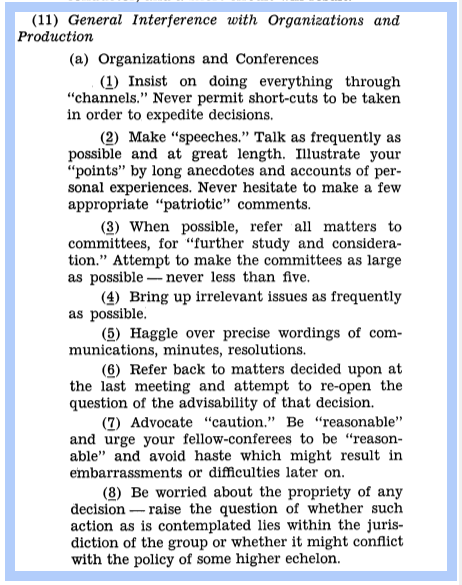
Simple Sabotage of Organizations
Charles Kettering, head of research at General Motors from 1920 to 1947, is known for the quote “A Problem Well Stated is Half Solved.” We talk a lot about all the ways organizations can pave the way to success – and that’s a good thing. This month, we are taking a different approach and flipping the script to talk about ways organizations can be sabotaged. Simple, persistent behaviors and habits can cause progress to be sabotaged when organizations are unaware of the problems that exist in the first place. We believe if you first know your nemesis, you can combat it with the proper tools.
Our inspiration derived from the Simple Sabotage Field Manual (snip of how to sabotage pictured right) which was originally published by the United States Office of Strategic Services (now the Central Intelligence Agency) in 1944, for use by agents in motivating or recruiting potential foreign saboteurs.

Agents were granted permission to print and circulate pieces of the document as needed. The now declassified booklet describes ways for civilians to inflict sabotage through ordinary means, so as to minimize undue attention. According to the document, the usual saboteurs were most often U.S. sympathizers who wanted to disrupt war efforts against the U.S. during World War II. The booklet provides instructions for undermining progress and productivity by non-violent and unnoticed means. Sections of it relate directly to the business world and are eerily consistent with things that are happening in businesses today.
Sections that relate to business are under the headings:
- Organizations and Conferences
- Managers and Supervisors
- Employees
- Lowering Morale and Creating Confusion
Since we are focusing on organizations this month, let’s take a look at the tactics listed under it:
- Insist on doing everything through “channels.” Never permit shortcuts to be taken to expedite decisions.
- Talk as frequently as possible and at great length. Illustrate your points by long anecdotes and accounts of personal experience.
- When possible, refer all matters to committees for “further study and consideration.” Attempt to make the committees as large as possible – never less than five.
- Bring up irrelevant issues as frequently as possible.
- Haggle over precise wordings of communications, minutes, resolutions.
- Refer back to matters decided upon at the last meeting and attempt to re-open the question of the advisability of that decision.
- Advocate “caution.” Be “reasonable” and urge your fellow-conferees to be “reasonable” and avoid haste which might result in embarrassments or difficulties later on.
Upon reading this list, did you find that some of these things sound familiar in your company? Simple sabotage could be happening without intentional ill-will. It might just be happening due to people in your organization lacking self-awareness along with not being aware of others. It could be happening due to bad habits that have gone unchecked for a long time. Perhaps it is both of these things and many other leadership issues.
Let’s get clear.
CLG helps companies get clear about their vision, mission, goals, strategy, structure, and people. We help organizations see things that may be sabotaging progress. Contact us today to address simple sabotage in your company and get on the road to success. Follow this content throughout the month of September as we continue to talk about organizational sabotage.
Do you like the Simple Sabotage concept? Stay tuned for the next three months as we explore simple sabotage relating to managers and supervisors, employees, and morale and confusion through our blogs and marketing emails. Click here to subscribe.
-Melissa Spangler
